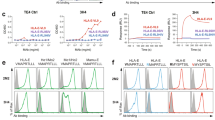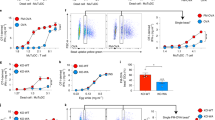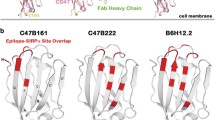Abstract
Natural IgM can recognize apoptotic cells, but the molecular structure and the role in macrophage phagocytosis of apoptotic cells remain unclear.
Objectives(1) To examine the binding of previously isolated natural IgM (3B4) to apoptotic cells and its effects on phagocytosis of apoptotic cells. (2) To characterize the molecular structure of 3B4.
Methods:3B4 binding to apoptotic thymocytes was examined by flow cytometry. Polyreactivity of 3B4 was assayed by ELISA. PKH26-labeled Macrophages were incubated with PKH67-stained apoptotic cells in the presence of 3B4. Macrophages phagocytosis of apoptotic cell was evaluated by flow cytometry. The DNA segments of 3B VH and VK were sequenced and analyzed.
Results:3B4 IgM recognized late apoptotic cells. Polyreactive-recognitions of lysophosphatidylcholine (LPC) as well as some autoantigens were observed in 3B4. Phagocytosis of late apoptotic cells was increased in the presence of 3B4. The VH and VK genes of 3B4 showed a germline gene context, while N-sequences and nucleotide loss were observed in CDR3. Conclusion: 3B4 promotes macrophage phagocytosis of late apoptotic cells in a complement-independent process. 3B4 has a germline configuration and is possibly ligand-selected. Out experiments suggest an independent role of natural IgM as opsonin in clearance of late apoptotic cells.
Similar content being viewed by others
Abbreviations
- PS:
-
phosphatidylserine
- MFG-E8:
-
milk fat globule EGF-factor 8
- CRP:
-
C-reactive protein
- SPF:
-
specific pathogen-free
- FITC:
-
fluorescein isothiocyanate
- PI:
-
propidium iodide
- BM:
-
bone marrow
- FR:
-
frame region
- CDR:
-
complementary determining region
- H:
-
heavy
- L:
-
light
- Ab:
-
antibody
References
Fadok VA, Voelker DR, Campbell PA et al (1992) Exposure of phosphatidylserine on the surface of apoptotic lymphocytes triggers specific recognition and removal by macrophages. J Immunol 148:2207–2216
Fadok VA, Bratton DL, Rose DM et al (2000) A receptor for phosphatidylserine-specific clearance of apoptotic cells. Nature 405:85–90
Hanayama R, Tanaka M, Miwa K et al (2002). Identification of a factor that links apoptotic cells to phagocytes. Nature 417:182–187
Mevorach D, Mascarenhas JO, Gershov D, Elkon KB (1998) Complement-dependent clearance of apoptotic cells by human macrophages. J Exp Med 188:2313–2320
Gershov D, Kim S, Brot N, Elkon KB (2000) C-reactive protein binds to apoptotic cells, protects the cells from assembly of the terminal complement components, and sustains an anti-inflammatory innate immune response: implications for systemic autoimmunity. J Exp Med 192:1353–1364
Hanayama R, Tanaka M, Miyasaka K et al (2004) Autoimmune disease and impaired uptake of apoptotic cells in MFG-E8-deficient mice. Science 304:1147–1150
Botto M, Dell’Agnola C, Bygrave AE et al (1998) Homozygous C1q deficiency causes glomerulonephritis associated with multiple apoptotic bodies. Nat Genet 19:56–59
Boyden SV (1966) Natural antibodies and the immune response. Adv Immunol 5:1–28
Hamilton AM, Lehuen A, Kearney JF (1994) Immunofluorescence analysis of B-1 cell ontogeny in the mouse. Int Immunol 6:355–361
Avrameas S (1991) Natural autoantibodies: from ‘horror autotoxicus’ to ‘gnothi seauton’. Immunol Today 12:154–159
Tomer Y, Shoenfeld Y (1988) The significance of natural autoantibodies. Immunol Invest 17:389–424
Lutz HU, Gianora O, Nater M, Schweizer E, Stammler P (1993) Naturally occurring anti-band 3 antibodies bind to protein rather than to carbohydrate on band 3. J Biol Chem 268:23562–23566
Baumgarth N, Herman OC, Jager GC, Brown LE, Herzenberg LA, Chen J (2000) B-1 and B-2 cell-derived immunoglobulin M antibodies are nonredundant components of the protective response to influenza virus infection. J Exp Med 192:271–280
Ochsenbein AF, Zinkernagel RM (2000) Natural antibodies and complement link innate and acquired immunity. Immunol Today 21:624–630
Boes M, Schmidt T, Linkemann K, Beaudette BC, Marshak-Rothstein A, Chen J (2000) Accelerated development of IgG autoantibodies and autoimmune disease in the absence of secreted IgM. Proc Natl Acad Sci USA 97:1184–1189
Ehrenstein MR, Cook HT, Neuberger MS (2000) Deficiency in serum immunoglobulin (Ig)M predisposes to development of IgG autoantibodies. J Exp Med 191:1253–1258
Kim SJ, Gershov D, Ma X, Brot N, Elkon KB (2002) I-PLA(2) activation during apoptosis promotes the exposure of membrane lysophosphatidylcholine leading to binding by natural immunoglobulin M antibodies and complement activation. J Exp Med 196:655–665
Shibuya A, Sakamoto N, Shimizu Y et al (2000) Fcα/μ receptor mediates endocytosis of IgM-coated microbes. Nature Immunol 1:441–446
Williams JP, Pechet TT, Weiser MR et al (1999) Intestinal reperfusion injury is mediated by IgM and complement. J Appl Physiol 86:938–942
Vollmar AM, Schutz R (1994) Gene expression and secretion of atrial natriuretic peptide by macrophages. J Clin Invest 94:539–545
Orlandi R, Gussow DH, Jones PT, Winter G (1989) Cloning immunoglobulin variable domains for expression by the polymerase chain reaction. Proc Natl Acad Sci USA 86:3833–3837
Kabat E, Wu TT, Reid-Miller M et al (1991) Sequences of Proteins of Immunological Interest Fifth Edition. US Government Printing Office, Washington, DC
Alt FW, Baltimore D (1982) Joining of immunoglobulin heavy chain gene segments: Implications from a chromosome with evidence of three D-JH fusions. Proc Nat Acad Sci USA 79:4118–4122
Gauss GH, Lieber MR (1996) Mechanistic constraints on diversity in human V(D)J recombination. Mol Cell Biol 16:258–269
Notkins AL (2004) Polyreactivity of antibody molecules. TRENDS in Immunol 25:174–179
Bendelac A, Bonneville M, Kearney JF (2001) Autoreactivity by design: innate B and T lymphocytes. Nat Rew Immunol 1:177–186
Casali P, Notkins AL (1989) CD5+ B lymphocytes, polyreactive antibodies and the human B-cell repertoire. Immunol Today 10:364–368
Ochsenbein AF, Fehr T, Lutz C, Suter M et al (1999) Control of early viral and bacterial distribution and disease by natural antibodies. Science 286:2156–2159
Baumgarth N, Herman OC, Jager GC, Brown LE, Herzenberg LA, Chen J (2000) B-1 and B-2 cell-derived immunoglobulin M antibodies are nonredundant components of the protective response to influenza virus infection. J Exp Med 192:271–280
Mills JC, Stone NL, Pittman RN (1999) Extranuclear apoptosis: The role of the cytoplasm in the execution phase. J Cell Biol 146:703–707
Quartier P, Potter PK, Ehrenstein MR et al (2005) Predominant role of IgM-dependent activation of the classical pathway in the clearance of dying cells by murine bone marrow-derived macrophages in vitro. Eur J Immunol 35:252–260
Author information
Authors and Affiliations
Corresponding author
Additional information
M. Fu, P.-s.Fan and W. Li contributed equally to this work.
This work was supported by grant from the National Science Foundation of China (30330510).
Rights and permissions
About this article
Cite this article
Fu, M., Fan, Ps., Li, W. et al. Identification of poly-reactive natural IgM antibody that recognizes late apoptotic cells and promotes phagocytosis of the cells. Apoptosis 12, 355–362 (2007). https://doi.org/10.1007/s10495-006-0581-z
Published:
Issue Date:
DOI: https://doi.org/10.1007/s10495-006-0581-z




